Off to Paris
Hi Everyone! I'll be taking a small, 1 week blogging hiatus while I stroll along the Seine, eat ratatouille and pretend to be Canadian. See you next week!
Hi Everyone! I'll be taking a small, 1 week blogging hiatus while I stroll along the Seine, eat ratatouille and pretend to be Canadian. See you next week!
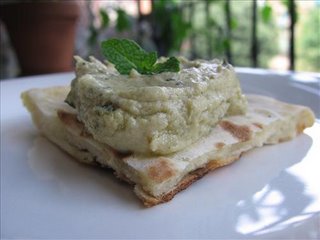 I'm keeping on the themes of great chilled dishes for summer as well as things I make after roasting all my market eggplants and red bell peppers. Today, it's Baba Ghanoush (or Baba Ghanoush or baba ganoosh.) As it is with terms borrowed from the Arabic, just pick your phonetic equivalent and run with it. Baba Ganoush is a Middle Eastern dip that goes really well with just bread or with vegetable crudités. Is is cooling and very much not like salad, which makes me happy these days.
I'm keeping on the themes of great chilled dishes for summer as well as things I make after roasting all my market eggplants and red bell peppers. Today, it's Baba Ghanoush (or Baba Ghanoush or baba ganoosh.) As it is with terms borrowed from the Arabic, just pick your phonetic equivalent and run with it. Baba Ganoush is a Middle Eastern dip that goes really well with just bread or with vegetable crudités. Is is cooling and very much not like salad, which makes me happy these days.
 The first time I had summer gazpacho I was at a graduate student pot-luck and a Basque colleague of mine brought some. Being very Basque and not at all Andalusian, "Ivan" just put in all the veggies from his fridge, including carrots and broccoli into his blender, chilled the result and called it gazpacho. I learned something that day about the strength of Spain's regional identities. Even I knew more about Andalusian Gazpacho than "Ivan", at least enough not to puree raw broccoli into soup! Needless to say, it took me years to ever try it again. I'd trust "Ivan" with Basque Bacalao a la Vizcaina any day, but not this southern Spanish delight. The real deal is a drinkable version of mixed salad with vinaigrette dressing. For a really funny gazpacho ingredient list that includes sleeping pills, see "Women on the Verge of a Nervous Breakdown" by Pedro Almodovar.
The first time I had summer gazpacho I was at a graduate student pot-luck and a Basque colleague of mine brought some. Being very Basque and not at all Andalusian, "Ivan" just put in all the veggies from his fridge, including carrots and broccoli into his blender, chilled the result and called it gazpacho. I learned something that day about the strength of Spain's regional identities. Even I knew more about Andalusian Gazpacho than "Ivan", at least enough not to puree raw broccoli into soup! Needless to say, it took me years to ever try it again. I'd trust "Ivan" with Basque Bacalao a la Vizcaina any day, but not this southern Spanish delight. The real deal is a drinkable version of mixed salad with vinaigrette dressing. For a really funny gazpacho ingredient list that includes sleeping pills, see "Women on the Verge of a Nervous Breakdown" by Pedro Almodovar.

If you’re having a hot summer and do not possess an air conditioner, as is the case for many (most?) Italians, chilled foods become really appreciated. For the last couple summers, I’ve gotten pretty tired of salad, even the delightful Caprese, after a couple months of eating it, leaves me well, cold. But this year, I discovered a delicious, light but satisfying vegetable dish that I plan to make a lot. It’s impressive to look at, so it goes very well as a fresh starter for a dinner party or a main course for lunch.
The morning after ingesting raw pork in the form of thinly-sliced Italian salt-cured pancetta, I awoke at 8:00 am.
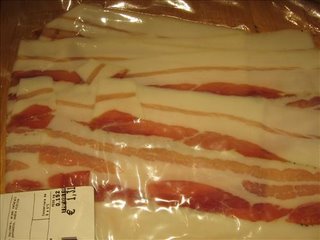 I've seen on my Statcounter that the second most common way people get to my site is by googling "Can you eat raw pancetta?". The #1 most common seems to be, "How to build a balcony" for which I just have no answer at all, sorry. The problem is that up until now, I have left the pancetta knowledge seekers unsatisfied. Today, I'm going to rectify all that, today I'm conducting a raw pancetta taste/health test.
I've seen on my Statcounter that the second most common way people get to my site is by googling "Can you eat raw pancetta?". The #1 most common seems to be, "How to build a balcony" for which I just have no answer at all, sorry. The problem is that up until now, I have left the pancetta knowledge seekers unsatisfied. Today, I'm going to rectify all that, today I'm conducting a raw pancetta taste/health test. 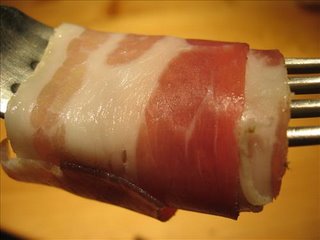 You see, lo these 3 years in Milan, I have yet to eat pancetta raw. I chop it up and fry it with vegetables to make a minestrone soup base, I stuff Thanksgiving turkeys with it, I wrap fennel and radicchio in it and bake them, but I've never dared to eat the stuff raw. Lots of Italians do this however and with no apparent trychnosis epidemic, so I imagine it's safe despite the fact it really looks exactly like raw bacon.
You see, lo these 3 years in Milan, I have yet to eat pancetta raw. I chop it up and fry it with vegetables to make a minestrone soup base, I stuff Thanksgiving turkeys with it, I wrap fennel and radicchio in it and bake them, but I've never dared to eat the stuff raw. Lots of Italians do this however and with no apparent trychnosis epidemic, so I imagine it's safe despite the fact it really looks exactly like raw bacon.  So, here goes: Gulp. Music to eat raw pork by: Somehow the gross thought of eating raw "bacon" calls for punk rock, don't you think? Today, I'll go with the Meat Puppets. Well, as for taste, it's got the very salty flavor of cured pork; I can't say it's as nice as prosciutto. This particular pancetta was not the most expensive at the store, so maybe I should have sprung for the fancy stuff. Yet, it certainly isn't terrible by any means. Time will only tell if there are any health consequences for eating raw pancetta. Tune in tomorrow for the belly report!
So, here goes: Gulp. Music to eat raw pork by: Somehow the gross thought of eating raw "bacon" calls for punk rock, don't you think? Today, I'll go with the Meat Puppets. Well, as for taste, it's got the very salty flavor of cured pork; I can't say it's as nice as prosciutto. This particular pancetta was not the most expensive at the store, so maybe I should have sprung for the fancy stuff. Yet, it certainly isn't terrible by any means. Time will only tell if there are any health consequences for eating raw pancetta. Tune in tomorrow for the belly report!
 Another of Amalia's delicious dishes was handmade eggplant-fresh mozzarella ravioli with a "simple" sauce of tomato concasse. I put quotation marks around "simple" because I'm almost always too lazy to go through the process of making it when it's called for in a recipe. But if your sauce consists of nothing but tomato concasse, you may as well try it. It's creme de la tomato, all rich pulp, no seeds or peel.
Another of Amalia's delicious dishes was handmade eggplant-fresh mozzarella ravioli with a "simple" sauce of tomato concasse. I put quotation marks around "simple" because I'm almost always too lazy to go through the process of making it when it's called for in a recipe. But if your sauce consists of nothing but tomato concasse, you may as well try it. It's creme de la tomato, all rich pulp, no seeds or peel.
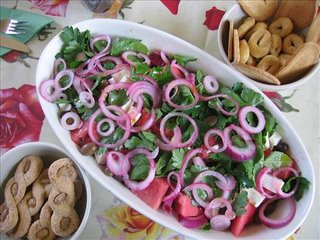 I could get used to this. I've been the beneficiary of such delicious hospitality lately. Gigliola, her family and I had lunch overlooking Lake Como and the mountains beyond; Amalia, her family and I ate al fresco on their enormous, vine-covered balcony. I may never cook again. Wonder how long they'd appreciate me showing up on the doorstep on a regular basis. Ladies?
I could get used to this. I've been the beneficiary of such delicious hospitality lately. Gigliola, her family and I had lunch overlooking Lake Como and the mountains beyond; Amalia, her family and I ate al fresco on their enormous, vine-covered balcony. I may never cook again. Wonder how long they'd appreciate me showing up on the doorstep on a regular basis. Ladies?
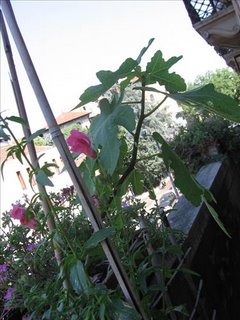 I may complain sometimes about the lack of great Mexican food here in Italy, no good mangoes, no tomatillos or poblano peppers to speak of, but all in all, Southern Europe kicks ass in terms of fresh produce. One of the most shocking examples of this are the fig trees you see growing everywhere like weeds. They spring out of cracks in walls and sidewalks, they grow by the side of the highway like so much poison sumac. In Chicago, figs when they are available, are revered. They appear at Caputo's Italian market for at least 2 bucks per pint and you don't even want to know what they charge for Whole Foods' fig preserves. In Italy, you reach up and grab them for free sometimes. In the open-air markets, they almost give them away yet no-one but me seems shocked at this. So lo and behold, at my friend, Amalia's house today what did I spy growing out of the window-box among the snap-dragons? This sneaky weed!
I may complain sometimes about the lack of great Mexican food here in Italy, no good mangoes, no tomatillos or poblano peppers to speak of, but all in all, Southern Europe kicks ass in terms of fresh produce. One of the most shocking examples of this are the fig trees you see growing everywhere like weeds. They spring out of cracks in walls and sidewalks, they grow by the side of the highway like so much poison sumac. In Chicago, figs when they are available, are revered. They appear at Caputo's Italian market for at least 2 bucks per pint and you don't even want to know what they charge for Whole Foods' fig preserves. In Italy, you reach up and grab them for free sometimes. In the open-air markets, they almost give them away yet no-one but me seems shocked at this. So lo and behold, at my friend, Amalia's house today what did I spy growing out of the window-box among the snap-dragons? This sneaky weed!
 After we ate the marinated baby zucchini with their flowers, Gigliola served us a puff pastry tart filled with zucchini and ricotta, which was as lovely as the first and completely different.
After we ate the marinated baby zucchini with their flowers, Gigliola served us a puff pastry tart filled with zucchini and ricotta, which was as lovely as the first and completely different.
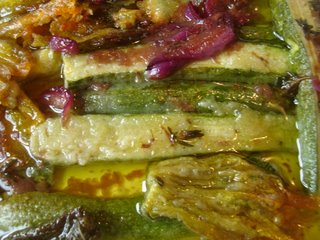 Mmm...I recently spent the day at my friend, Gigliola's house in Como. Presumably not far from the very attractive and politically right-on (left-on?) George Clooney, we had a delicious lunch and started working on an English-for Science-students project.
Mmm...I recently spent the day at my friend, Gigliola's house in Como. Presumably not far from the very attractive and politically right-on (left-on?) George Clooney, we had a delicious lunch and started working on an English-for Science-students project. I’ve read a lot recently about a Chinese dish that almost no Chinese restaurants serve abroad. Twice-Cooked Pork Belly, yep, that’s fresh, uncured, unsmoked bacon boiled and then slow-baked (or if you’re lucky enough to cook on a grill, barbecued. Now I’ve READ a lot about this dish but have seen almost no recipes that specify clearly HOW the pork should be cooked. Or they suggest boiling first then stir-frying it in pieces, which I find unappealing. And most online mentions of the term are descriptions of the delicious food you can order in Australia’s better restaurants. Any Australians or Chinese out there who can give me a heads-up on this? I really wanted a step-by-step guide to this since I’m wondering how I’ll get enough of the fat (and there’s a LOT!) rendered, so this’ll be good, not excessive and disgusting. So today, I’m winging it. I figure that if I first boil the pork whole in salted, garliked water until the water has completely evaporated and then let the fatty side brown in the pork’s own rendered fat, I’ll be halfway to getting the bacon to be more like a really tender regular piece of meat, not bacony at all. Then, I’ll rub on a sort-of spice paste and put it in a not-so-hot oven for a couple hours. After that, we’ll see if the meat turns out tender and yummy. If I had access to a grill, I’d slow barbecue it.
A little over 3 years ago, we had our wedding reception dinner at Charlie Trotter's in Chicago and the experience was a thing to remember! In fact a number of guests actually took photos (sadly, not digital) of all the courses so we have the whole meal documented. The chef (not Charlie) came out to greet us at the end of the meal and offered us some free cookbooks, Charlie Trotter’s biography, a copy of the evening’s menu and a European Hotel/Restaurant Guide since he knew we were moving immediately to Italy. One of my cousins got a chef’s touque and my dad, a CT baseball hat. We took a tour of the bustling kitchen One thing that struck me about the incomparable food at Trotter’s was the persnicketyness of everything. Anal retention and perfectionism seem to rule in that place which does make for some fabulous cuisine but I’ll bet working in the back is tough! Of the 2 cookbooks, “Charlie Trotter’s Seafood” and the more accessible, “Charlie Trotter Cooks at Home” (He does?! Hmmm…I don’t buy it.) I have made precious few recipes. A typical seafood recipe in the fancier book calls for things like preserved turmeric, verjus, poached quail eggs or tatsoi. Even the homey book is pretty complicated with 2-3 mini recipes required to make each dish (not much of a problem for me) but the ingredients are, I dunno. Elite? Not run-of-the-mill? The poultry section has more duck breast recipes than chicken. So I don’t use these books much. However, in the homey book there’s a basic recipe (meant to go into a more complicated final dish) for roasted mushrooms that is very easy, yet like anything Charlie, DIVINE.
 Yesterday, we took a train out past Milan's suburbs and then rode our bikes to the lakeside town of Lecco. The towns around Lake Como are so beautiful since they are both on the water and among gorgeous mountains. We had clear skies, warm (not hot) weather and pretty strong breezes. A lot of the town was out in the piazza enjoying the afternoon in grand Italian Sunday-stroll style. So, we did the same.
Yesterday, we took a train out past Milan's suburbs and then rode our bikes to the lakeside town of Lecco. The towns around Lake Como are so beautiful since they are both on the water and among gorgeous mountains. We had clear skies, warm (not hot) weather and pretty strong breezes. A lot of the town was out in the piazza enjoying the afternoon in grand Italian Sunday-stroll style. So, we did the same.

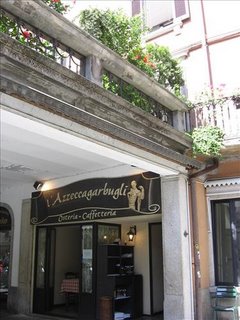
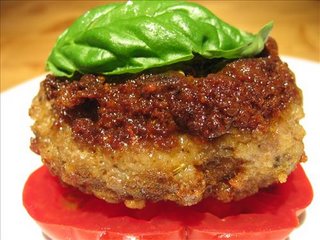 You may have read complaints in this blog about how here in Northern Italy I haven’t found “Italian” (at least I thought it was) sausage. You know the kind, with fennel seeds if it’s mild and fennel + red pepper flakes if its hot? The most delicious grill item served on a piece of Chicago Gonnella or Turano long loaf with a slice of tomato or sweet peppers? Well, a while back I did find some mild sausage with fennel seed, got all excited, bought it, took it home, cooked it and was very disappointed. I cooked it thoroughly, until the casing was dark dark brown. Well, ok, I burned, it. I forgot it on the stove and it ended up way over on the side of well-done. But the interior was still pink, thoroughly cooked but pink. It’s as if they used so much food coloring that the pink never gave way to the brown of cooking. Yeesh!
You may have read complaints in this blog about how here in Northern Italy I haven’t found “Italian” (at least I thought it was) sausage. You know the kind, with fennel seeds if it’s mild and fennel + red pepper flakes if its hot? The most delicious grill item served on a piece of Chicago Gonnella or Turano long loaf with a slice of tomato or sweet peppers? Well, a while back I did find some mild sausage with fennel seed, got all excited, bought it, took it home, cooked it and was very disappointed. I cooked it thoroughly, until the casing was dark dark brown. Well, ok, I burned, it. I forgot it on the stove and it ended up way over on the side of well-done. But the interior was still pink, thoroughly cooked but pink. It’s as if they used so much food coloring that the pink never gave way to the brown of cooking. Yeesh!